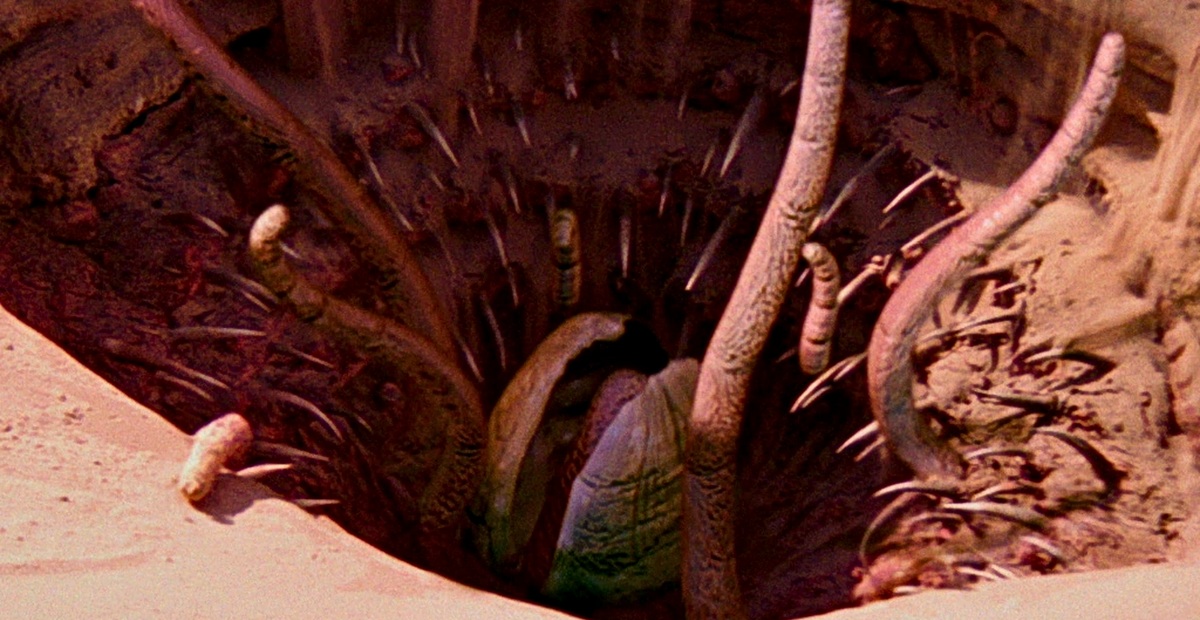If you ever ended up in a sarlacc pit, things weren’t over quickly. Crime lords knew that better than anyone. Dropping someone into the Great Pit of Carkoon was a sentence that could stretch across centuries. What you saw on the surface — the ring of teeth, the beak, the writhing tentacles — was only the entrance. Most of the sarlacc lived hidden below, a massive creature buried in the sand, waiting patiently for prey. On Tatooine, that quiet threat was enough to keep enemies obedient.
“In his belly, you will find a new definition of pain and suffering,” C-3PO once translated for Jabba. That wasn’t an exaggeration.
From Fall To Holding Cells
Falling into a sarlacc doesn’t mean you land in one big stomach. Its throat decides where you go based on your size and how much you fight back. If the main chamber has room, you’re dropped there. If not, you’re rerouted into one of several secondary stomachs — tight, coffin-like spaces where inner tentacles hold you still.
In those cramped cells, the process begins. Acids start dissolving skin and muscle, but they don’t kill right away. You stop being able to move quickly, yet you stay conscious. Victims often describe being squeezed, sliding deeper, and then left completely still — waiting for the next stage.
The primary chamber is where digestion truly starts. Thick fluids coat your body, and inner tendrils inject toxins that keep you awake but unable to resist. Over time, your body fuses with the stomach wall, turning you into a living part of the creature. At that point, even if someone pulled you out, you wouldn’t survive — your body and the sarlacc are literally woven together. The acids strip tissue layer by layer while the tendrils anchor what’s left deeper inside.
Once you’re part of the lining, you’re no longer a person — you’re part of the sarlacc’s system. (See inside the Sarlacc here with visual explanations)
Centuries Awake – A Plant-Like Predator With A Collective Mind
The toxins don’t let your awareness fade. Instead, the sarlacc’s body cycles acidic fluids through you, maintaining a steady level of pain. Victims don’t pass out quickly. Some remain conscious for hundreds of years, and in rare cases, digestion might take close to a thousand.
Scientists studying telemetry from Boba Fett’s armor came to a strange conclusion: the sarlacc behaves more like a plant than an animal. It spreads through spores, drinks water from the ground, and senses vibrations like roots. Adults rarely move and can survive decades between meals. At the same time, it hunts with tentacles, sorts its prey by threat, and reacts intelligently. It’s a strange mix — a semi-sentient hybrid that can live from 20,000 to 50,000 years.
There are even reports suggesting something more disturbing. In rare cases, early victims might merge their consciousness with the creature, forming a hive-like awareness. Some evidence points to telepathic torment — the sarlacc actively feeding on fear to keep its prey docile.
Rare Escapes And What We Learned
Escaping the sarlacc is almost impossible. Boba Fett is the most famous example. His sealed armor held off the acids long enough for him to use his jetpack and blast his way out through the creature’s mouth. He barely survived, but the data from his suit gave scientists a detailed look at how the sarlacc digests, restrains, and preserves its victims.
A few other cases exist in Legends. A Hutt was once spat out. A girl named Shaara was thrown up instead of digested. Starkiller slipped into and escaped from a Felucian sarlacc pit during a mission. But these are exceptions. Almost everyone who falls in is never seen again.

